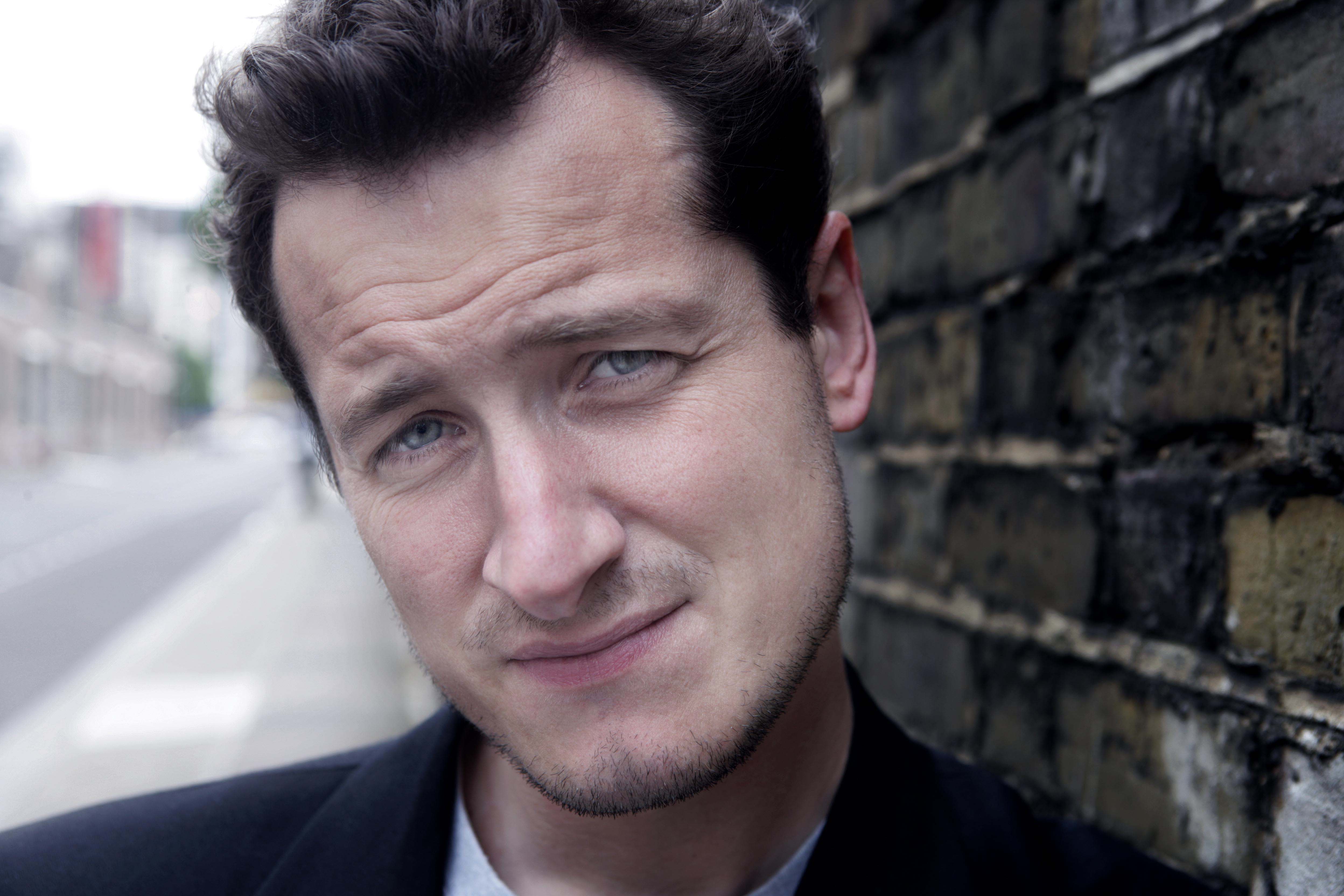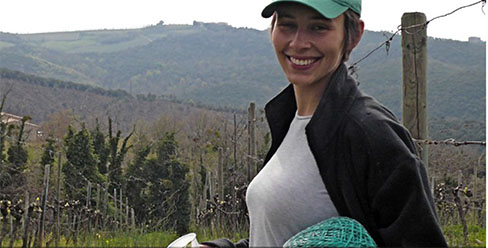
The husband and wife team of Pierre Jean Monnoyer and Kalyna created their estate, Casa Raia, in 2006. The estate once belonged to the patriarchal family of Brunello di Montalcino the Biondi Santi. The Monnoyers make low intervention Brunello di Montalcino without commercial yeasts or other chemicals in the cellar. Their south and southwest facing vineyards are located at 1,200 feet and comprise of classic Brunello clay and limestone soils. The couple farm using organic and biodynamic methods.
Monty Waldin talks to Kalyna Monnoyer.
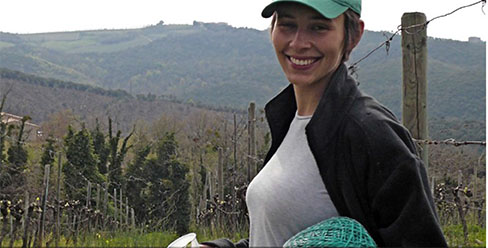 Monty Waldin: Let’s start by asking how you ended up at this estate.
Monty Waldin: Let’s start by asking how you ended up at this estate.
Kalyna Monnoyer: Briefly, I used to come here as a child. My mother used to bring us here on holidays. As an artist, it was her life-long dream to have a house in Tuscany. She had a deep connection with Italy, for its natural beauty, but also its culture and history, so she brought us here. She always dreamed of buying this property, so one day she did. Many years later, when I met Pierre-Jean, my husband, we came here to work in the vineyards. We worked on some organic vineyards. We were encouraged to take on the vineyards on this property.
How big was the vineyard when your mother bought the house? What sort of property was it— a young vineyard, old vineyard, ruined vineyard?
This vineyard was already 40 years old, and it was going down in production. The winemakers at that time didn't want it any longer because it wasn't producing enough. However, the quality of the wine was exceptional, really exceptional, so much so that it even won prizes in 1997. We decided to take it on and to regenerate the land, the vineyards, the soil, and make a very high-quality product out of it, since it was small in quantity.
In which year did your mother buy the estate?
She bought it in 1996, I believe. 1997 was the first vintage when she was here and it was a great vintage.
It's not that long ago, but a lot has changed since then. How do you see the development of modern Brunello?
There are some exceptional wines, for sure. There has been a change in the the rules. They have reduced the number of years of aging the wine. Originally, it was roughly four or five years in wood. Now, I think they brought it down to two years in wood and one in the bottle. That's a big change, and I think it's really commercially motivated.
Is it a good change or a bad one?
It depends. For us, the Sangiovese really merits being aged, and there's a certain amount of time for us, it's usually around three to four years when it seems like it's ready. Bringing it down to two years? It just doesn't seem like enough time to me. No, so we keep it to four in wood.
 We described your view of the rules regarding the tradition, in terms of wine style, what's your view of the traditional versus modernist tendency in Brunello?
We described your view of the rules regarding the tradition, in terms of wine style, what's your view of the traditional versus modernist tendency in Brunello?
In terms of the type of containers used?
In terms of oak, in terms of fruit expression in the wine, perhaps more like Bordeaux-style wines, more traditional Tuscan-style wines?
I think that it really depends on the winemaker. It’s difficult to generalize because everyone has such a particular style of winemaking. I think one can go away from the traditional style of winemaking, and adopt other ways, as long as they stay true to the most important thing, that they come out with a nice product.
Brunello became very famous very quickly, almost out of nowhere. It wasn't like Bordeaux, or Burgundy or Champagne. It suddenly arrived on the international scene.
Yes, it did, didn't it?
Almost as if by magic. What was your view of some of the wines being made then? Did you think the majority of wines suited your palate, or did you think that everyone should make the wine as they chose? Has there been a little bit too much standardization, internationalization?
Yes, perhaps. Perhaps there was a bit too much...The need to attract a certain market, we all know, so that probably also changed the wines and the way they were made, traditionally, the way that they were intended to be made.
In certain markets the focus was about high point scores and perhaps wines made more for journalists than for wine consumers?
Yes.
Do you think we're moving into something a little bit more subtle now?
I think so. Actually, I think there's a big change happening in winemaking. I don't know if we're seeing it just because we're a natural winemaker, but for instance, even in Montalcino, the Montalcino Bio has just been born.
The organic wine growers group?
Yes, now there are some big producers there, and there are 50 producers now, and 70 producers will be included in the next couple of years.
That's about one in three!
When we arrived, there were 10, so I think there's a tendency to go that way. Why is that important? It’s important because we're going back to tradition. If you're making natural wine, you're taking out all of those things that were added. You're taking all the chemicals, and powders, and so on, out of the wine, so you're essentially making the wine traditionally. You're making it from the vineyard, and really, that's what we do. We make the wine from the vineyard. My husband, also, will attest that it's simple, in fact, when you make wine that way. We aren't the ones that create it. It's the vineyard that does, so we just take care of the vineyard and that's it. We do the best we can.
 Just to start, we're in a very special area, Montalcino's a very big wine growing region. In terms of its geography there are very many different variations. Just explain exactly where we are, where your vines are.
Just to start, we're in a very special area, Montalcino's a very big wine growing region. In terms of its geography there are very many different variations. Just explain exactly where we are, where your vines are.
This is going to be difficult to explain because there's no name for this area. There really isn't. [Nearby] Montosoli, Canalicchio. We're sort of in between. There are very few of us in this area.
Are you near or far from the town?
We're close to the town. We're 360 meters in altitude, so we have a nice altitude. When the fog rolls in, we escape it. It's really nice. We have a bit of volcanic soil here.
That's quite unusual.
Yes, It’s quite unusual. This terroir is very unusual. As you can see there's a piece of land that is adjoined to our vineyards. It's in fact where our vineyards are, on the terraces there, that was Biondi Santi's first vineyard, in fact, where Brunello was born, so it's very particular, very special.
When you started, obviously, your mum bought the house, you had an old vineyard that was nearly on its last legs. How did you bring the vineyard back to life?
Our dream was to bring this vineyard back to life. It was already 40 years old, so our idea was to take the soil and regenerate it. We're using all sorts of methods, so from organic—we use permaculture, or regenerative agriculture, and biodynamic, we use all of these different techniques to regenerate the soil, adding green manure to build up organic matter in the soil and rebuild the microorganisms that are missing due to soil erosion. After many years of working the land and turning the soil, the soil had eroded and we needed to build it up again, and also create the life that's in the soil. I think natural winemaking is all about that. It's about the life in the soil, in the vines, in the wine, so that's really what it's about for us. In fact, it’s the same with the wine in the cellar. It's a living thing. It's quite powerful, actually.
Do you bottle by the moon and do things like that, or are you a little bit more Cartesian?
We do bottle by the moon, yes. Yes, but we won't exaggerate because there's only so much time, and until now, there has only been the two of us, so obviously, we can't always follow a calendar. We have to do things when they have to be done, of course.
Geographically, Montalcino is a huge area. It's sometimes confusing for consumers to identify which Brunello comes from which subzone, if you like, of the region. Do you think zoning, dividing the Montalcino area up into little subzones would be useful? Presumably you would be classified a town or something similar? You're right underneath the town.
Yes, we would be classified Montalcino.
Would that be useful or would it be too confusing for people?
I don't think it would be confusing. I think an educated wine buyer would be able to distinguish and to choose according to the zones. It could be useful, of course, but one would have to consider that it's not only the zones that are important. It's also the winemaker, the methods in making the wine; it's very subjective. You could be in a zone that's less appreciated, for instance. Let’s say you're near the river, the Orcia, but it could be an excellent wine, as well, because of the methods that they use, they've adapted to the zone.
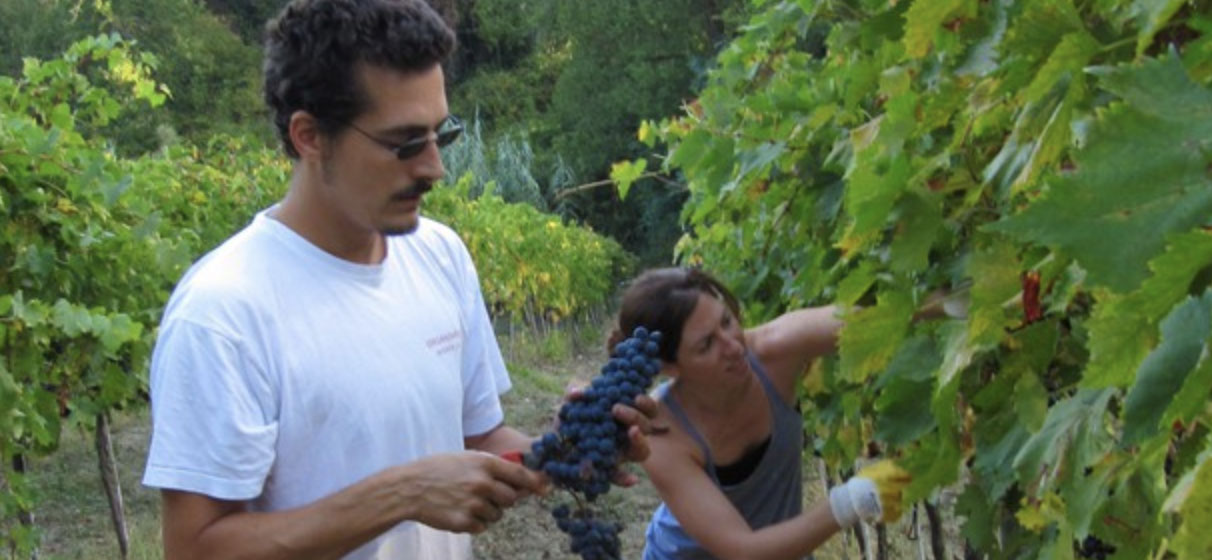 How do you style your wine? What kind of consumer do you think will like your wine?
How do you style your wine? What kind of consumer do you think will like your wine?
To tell you honestly, we never really style our wine. We never think about it that way. It's quite funny because we're such a small producer that we always just try to make the best possible wine we can. Of course, we make choices as to which kind of wood to use, and that's probably due to the fact that my husband's French, so we use French oak. I don’t think we have really styled it to a particular market. It's just a really personal thing.
It turns out like it turns out.
Yes, it turns out like it turns out. We just do our best. That's the principle.
Lighter wines go a bit easy with food. People want to finish the bottle. It's too heavy otherwise, isn't it?
Yes.
I'm not sure a lot of people are going to buy Brunello just to-
I think people buy Brunello for what it is. It is a rather complex wine. I don't think you can get away from that entirely. I think you'd have to go to another winemaking area. Yes, perhaps consumers can look to the Brunellos.
How about just talking about the terroir of the estate, how it's different from some of the other estates? Your terraces, for example.
We're on terraces, which is interesting.
Can you describe your vineyard? You've got a very unusual situation here.
Yes, we have an unusual situation. We are north-facing, however, we're on a hill, so we have all the winds, the Tramontana, and the Sirocco for example. Plus, we're very well exposed. On the south side, we have terraces, stone terraces, which is rather unusual in this area. The advantage of the stone terraces is, actually, the minerals that it brings to the grape. It definitely adds to the wine because of the minerals that come from the terrace walls.
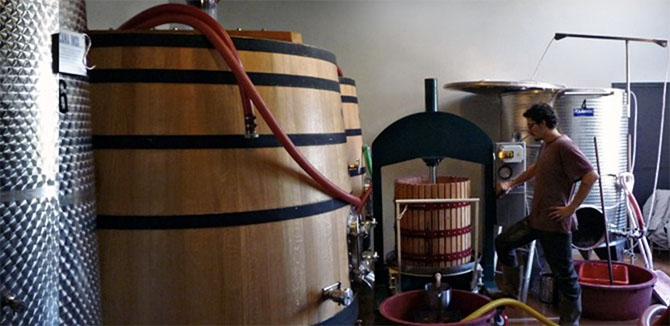 You mentioned the wind. How important is the Tramontana, which is the colder, mountain wind and the Sirocco which is a warmer wind. How important is it in terms of being organic? Is it helpful or is it a hindrance?
You mentioned the wind. How important is the Tramontana, which is the colder, mountain wind and the Sirocco which is a warmer wind. How important is it in terms of being organic? Is it helpful or is it a hindrance?
It's very helpful, yes. It's very helpful because if we were sitting low down in the valley, there would be a lot of humidity and stagnation, whereas in our vineyards, we always have a nice breeze flowing through, so it keeps out the mildew and the humidity.
In terms of style, how would you describe your Brunello?
I would say that our Brunello is a rather complex, robust wine. It is not a wine to be taken lightly. It's rather-
Forceful?
Yes. I would say that, however, it is well-balanced, so it is rich and smooth.
A little bit spicy.
Yes, it's a little bit spicy.
What would be a typical dish from this region that would pair well with your Brunello?
From this region? I would say a peposo. A peposo is a meat dish cooked in wine, in red wine, with lots of pepper and garlic, and stewed for three hours, so it's a very rich and weighty dish. It can definitely complement a wine like a Brunello because it's an important wine. Of course, the wine, when it's aged, changes. The characteristics change even after one year, two years. It's already changing.
